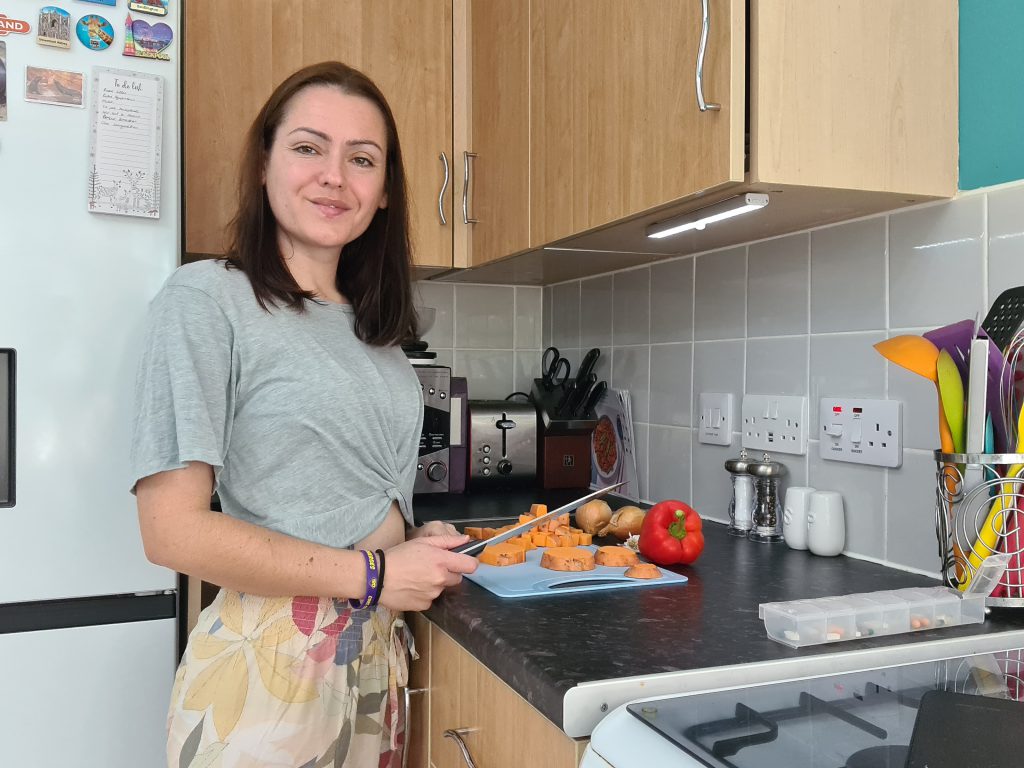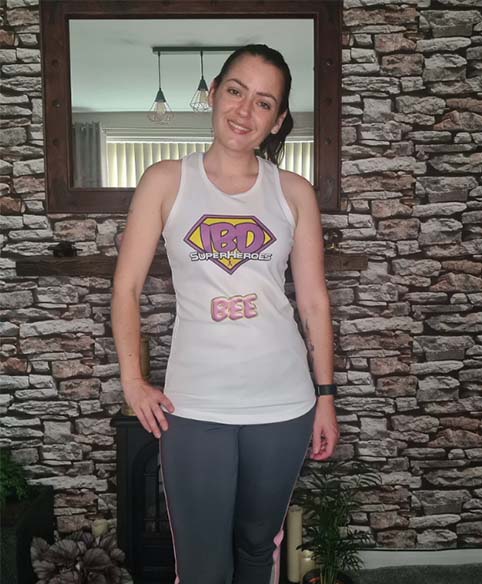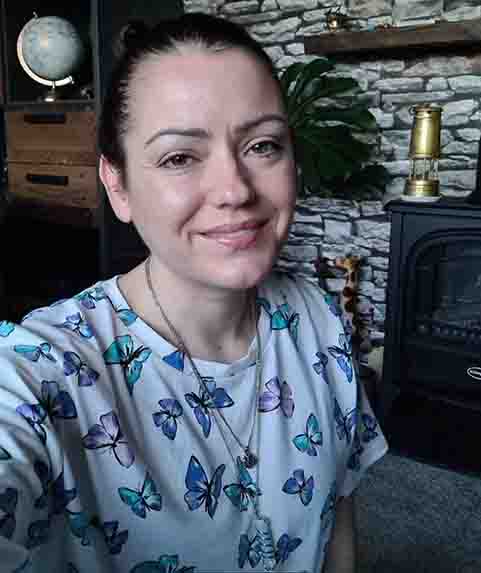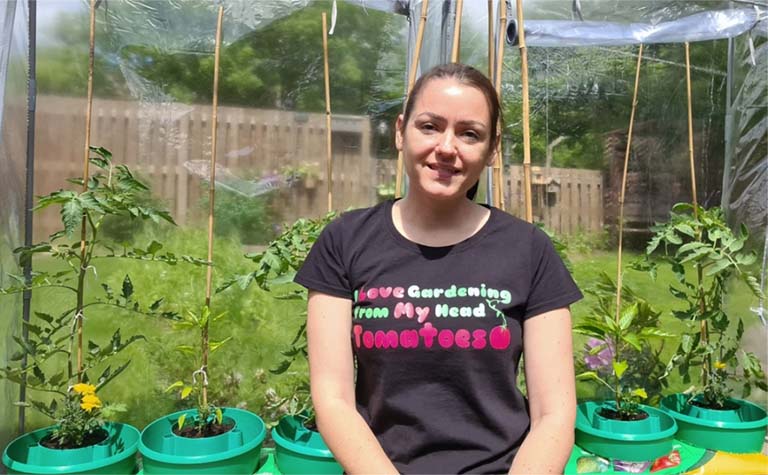
My first ileostomy, in 2007, was created as an emergency. I’d been diagnosed with ulcerative colitis not even a week prior.
At the time, I was in denial about how much impact losing my colon was really going to have on my life. On my body. The stay in hospital had been a traumatic experience. I’d had sepsis, C-diff, and post-op ileus (meaning my bowel wasn’t contracting to push anything through, so whatever went in just sat there until it came back up).
The harsh reality of life with a stoma
Reality set in once I was home, and I was faced with caring for my stoma by myself, whilst also trying to recover from what had ended up being two major, emergency, life-saving surgeries (the second one due to the sepsis). I didn’t receive proper support. A stoma nurse came out to see me, but she only seemed interested in ensuring I could change my bag by myself. There was never any discussion about lifestyle; clothing, exercise, sex etc. I was just given a list of foods to eat and avoid. Looking back, I think I was still in shock. I hadn’t asked her any questions either, I’d just made assumptions. Assumptions, which I later realised were wrong. Much too much later!
I tried to just go back to my life, pretending that my ileostomy didn’t exist. Admittedly, my life had mainly been working and alcohol consumption ahead of surgery. Fatigue led to me cutting my work hours and my body didn’t really tolerate alcohol anymore. I was utterly miserable because I couldn’t wear what I wanted to wear, my ostomy bag was constantly leaking, and my skin was always burnt, sore, and itchy. I remember thinking that life as I knew it was basically over. I didn’t like my life and I didn’t like me… I’d given up, but I knew it was only a matter of time before I could have my J-pouch built and a stoma reversal.
After two years, the stoma was gone. I figured I could finally return to my life. I was thrilled that I could wear whatever I wanted. I took great pleasure in throwing out all of the clothes I’d been wearing during my two years with a stoma. I was certain that I never wanted to live with a stoma ever again. At that time, I believed an ostomy was a barrier to living a full life.
Changing pace
My happiness was short lived because I soon developed pouchitis in my J-pouch. I was constantly swinging between flares, attending hospital appointments, tests, and medication, to rushing back into drinking and socialising, which I still considered my “normal” life. I was experiencing the life of a sick person, but I didn’t want to accept that that’s what I was. That was, until I had no choice. Eventually, I was just too tired to keep leaping back into my old life. I didn’t want to keep having to dig so deep for energy reserves. I felt like that period of my life, and the social elements had gotten me through some things I needed to get through, such as an abusive relationship and a career change, but it wasn’t going to serve me anymore. It had also helped me avoid dealing with the health stuff I wasn’t ready to face yet, but I knew I needed to slow down a bit, and to take my head out of the sand.
That’s when I began trying to educate myself better about my IBD. I didn’t stop going out altogether, it just changed pace. So, rather than drinking and dancing all week long, I just went for a few quiet drinks on a Friday after work. That first change of pace started the ball rolling and allowed me to start listening to my body, which ultimately meant I stopped drinking alcohol all together.
Learning to listen to my body
Listening to my body was one thing, but actually interpreting what it was saying, and needing, was another. I tried many a weird diet, cleanse, detox, supplement regime… Eventually I realised that stress was the biggest of my problems. Recognising it and changing are two very different things. You can’t just change how you react to life overnight. It was even more challenging because my health continued to go up and down.
Stress management, much like everything-else-in-life management, is constantly a work in progress. The first step I took was trying to learn not to sweat the small stuff. Second, I removed people from my life that weren’t a positive influence.
Processing the hardships and trauma
Being involved in the online IBD community made a BIG difference. It was only then, in 2014, that I realised how lonely I’d felt throughout the last seven years. I’d bottled up a lot of thoughts and emotions. Being able to share the rough bits and knowing that the people I was talking to truly did get it was wonderful. I think beginning to write blogs and being open with the community helped me start to process a lot of the stuff I’d been avoiding. I still to this day struggle with being open about my feelings, but I am at least aware of it, and I’m trying to be better at it.

Returning to life with an ileostomy
I have the online community to thank for getting me through my next surgery. Yet another emergency, which required an ileostomy for five months, due to an abscess and twisted intestine. It was a better stoma, and I got really good advice and support from the community, which made the whole experience feel much more manageable. I didn’t even need to change what I wore. I just got support garments to keep everything flat and in place!
I had that stoma reversed in late 2014, but in 2018 I had my Jpouch removed in favour of a permanent stoma, as the pouchitis was as stubborn as me and refused to be tamed.
I was so hopeful that with the Jpouch gone, I could start to live life on my own terms at last. I was planning a career change, as my job was a big source of stress for me. I achieved it, but that came with unforeseen repercussions when I began to gain weight. Initially, it was a good thing. I’d struggled to even maintain my weight for the last eleven years, so my diet was high fat, high sugar, high carb. I started to look healthier, but the weight gain didn’t stop. I even started experiencing bag leaks as a consequence.
Amending my diet
Changing my diet was really hard. Reducing my intake of starchy foods meant liquid output became a problem, which also caused leaks. I started using gelling sachets which solidify the liquid, which made a huge difference! I have to be careful with fruits and vegetables that contain insoluble fibre. If I chew thoroughly and have a small enough portion, I’m usually OK. I can actually tolerate a lot more than I could with the pouchitis, although there’s a few things I still can’t tolerate at all. Going overboard can lead to pain and intestinal blockages, so I try to get most of my fibre in soluble form, and I overcook a lot! Still, my diet is actually much healthier than it’s ever been before.
Introducing exercise
Changing my diet wasn’t enough though. It took me a while (an embarrassing amount of time, actually), to figure out that my previous job had meant that I was walking for 40 minutes every day. I think that’s because I’d not considered it “exercise”, it was just my commute.
I began trying to make myself move more to shift the weight, but pain was making it really difficult. I’d been experiencing a much higher amount of pain since my last surgery, which I’d put down to many things over time. Initially relating to recovery and then later blaming it on things like the mattress. I was eventually diagnosed with fibromyalgia, which at least helped explain it. That led to another episode of having to educate myself. I think the previous diagnosis and whole journey to acceptance process had prepped me for chronic illness in general. I didn’t really grieve too much. I was frustrated and angry, but I was still very aware that my emotions and stress levels needed to be managed. Even more so actually, to help manage the fibromyalgia. The more I learnt, the more I started to understand how so many things interplay with each other. I realised that managing my pain was going to be a much bigger task than I’d originally expected. Things like mental health, stress, sleep, relationships, all needed addressing as part of the bigger picture.
It took a long time, and a lot of pacing and trial and error to start being able to do things, but I got there with perseverance. I am still by no means an “active” person, but I do enough to help me maintain a weight that stops my bag leaking!
I do yoga and walk the dogs every morning. I have to get up 2 hours before I start work (I work from home) to fit them in. I’ve tried doing things later in the day, but my fatigue just doesn’t allow for it. I did also take up swimming because I remember loving to swim. I still do love to swim, but the pool was always cold and often very busy, which when I weighed up the pros and cons was actually often causing more stress than it was alleviating, so I stopped going.

Other lifestyle changes
My entire life is basically planned around managing my health and my pain levels, which allows me to actually live a little in between. Taking my medication and doing my physio exercises etc., are all super important.
One of the benefits of walking the dogs every day is just being able to get out into nature, which most people know is a great mood improver! Another benefit is getting out into the daylight at the same every day. This is a top sleep hygiene tip which can actually help you sleep better at night! How I sleep impacts my pain levels, so I go to bed early every single night and I stick to a sleep/wake routine, regardless of weekends and holidays.
I find yoga really helpful for my pain too. So much so, it’s allowed me to reduce some of pain medication, but I HAVE to keep it up. I never expected to feel any psychological benefit from it, but I really do find it helps manage my stress, which is so important for inherently-stressy me!
Another MUST for stress management is ensuring I have some quiet time every day between finishing work and starting the evening meal. It doesn’t matter what I do, as long as I enjoy doing it. In the Summertime, I love to garden. I can’t even put into words the stressbusting effects of gardening. I am still trying to learn when to stop though, as I regularly do it for too long and cause more pain! When there’s nothing to do in the garden, I have houseplants to tend to, series’ to binge, and new crafts to try.

Finally, I’m selective about who I spend time with, and what we do with it. I don’t want to feel pressured into doing things I don’t want to do, and I don’t want drama or negativity in my life. A food festival, live music, or a visit to an open garden are all perfect things to do on summer days. I enjoy flower shows, chatty walks, and lunch with friends. I’ve even been known to force friends to come over and watch Harry Potter!
I think it’s important to realise that there’s no one-size fits all when it comes to a healthy lifestyle. As I said earlier, I’ve tried many diets over the years. I’ve tried journalling, meditation, and acupuncture etc. I want to be the kind of person that enjoys a relaxing bath, but I just don’t. It’s about finding what works for you. Giving everything and go and seeing what happens.
It’s funny to think now, that I believed a stoma was a barrier to living a full, happy, healthy life! There’s no way I’d have been able to do half of the things I do now, when I was unwell!
We hope you enjoyed this article from our guest blogger. They are expressing their views or knowledge on a topic because of their experience & background. Some of the opinions expressed may not reflect the views of Fittleworth or your NHS professional.
It goes without saying, but this is not clinical advice. Each person will have an individual set of medical factors to consider. So please do not to make significant changes to your diet, exercise or treatments before consulting with an NHS professional.
Sahara was admitted to hospital and diagnosed with Ulcerative Colitis at the age of 19, after just two weeks of being incredibly unwell. One week later, she had emergency surgery to remove her colon and rectum, and had her first ileostomy. A turbulent journey followed; a multitude of treatments, complications, seven surgeries, a failed J-Pouch, and three ileostomies later, she is living with a permanent stoma and is a pro-active IBD and ostomy advocate.

Sahara Fleetwood Beresford – Ostomy Blogger
Sahara joined the online IBD and ostomy community in 2014, and it very quickly became apparent to her that whilst awareness is important, even more important than that is providing support to others as they navigate the stormy waters of life with IBD, or an ostomy.
She runs #IBDSuperHeroes fundraising and awareness campaign, and the Facebook support group. She is a blogger for InflammatortyBowelDisease.net and an IBD Patient Consultant for merakoi – bridging the gap between patients and healthcare. She gets involved with research whenever she can, and is a volunteer for Cure Crohn’s Colitis, where she donates her time and expertise in social media marketing and content creation
